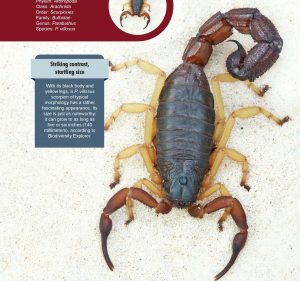The black hairy thick-tailed scorpion (Parabuthus villosus) is hard to miss, regardless of one’s affinity for creepy-crawlies. Hailing from South Africa, it is the biggest Buthidae species, according to a 1984 article by Alexis Harrington published in the Journal of Arachnology.
It prefers a diet of small mammals and reptiles, such as mice and lizards, and is often up and about when it’s neither light nor dark, preferably during dusk or dawn.
Its size and color make it both intimidating and alluring, an attractive arachnid for many scorpion keepers. Sadly, this also means it is sometimes acquired by hobbyists who might not be up to the challenge.
John Valentin Chua, breeder and friendly Animal Scene expert, tells us more about the typical morph of this scorpion species.
Q: Can you give us a basic introduction to the Parabuthus villosus “typical morph”?
A: [The typical morph of P. villosus] inhabits rocky areas where the substrate is gritty and clayey. There, he digs burrows under rocks or stones. (Source: Venomlist.com) [It is a] bit smaller than the orange morph, and its legs are light yellow. [It can grow to] around 3.5 to 4 inches as an adult.
Q: How did it come to the Philippines?
A: Exotic pets like this scorpion are imported from [their] country of origin. Then, hobbyists in our country breed them and sell them to the local market.
Q: How venomous is it?
A: [The black hairy thick-tailed scorpion has a] venom level of 5 (very lethal). These cute creatures are packed with very painful venom. So, safety first! You can look, but [don’t] touch.
Q: Aside from its appearance, why else this is an interesting creature?
A: Like its cousins, [what makes this scorpion unique] is that it’s like a toy at first glance. You would think they’re toys until they start to move around.
Q: What is the ideal enclosure for these scorpions?
A: I use a Kritter Keeper for its enclosure. For the substrate, I use coco peat bricks and fine white sand. Put at least two plastic pots halved in two. Place a shallow water dish for adults. As for scorplings (baby scorpions), you can mist their enclosure walls once a week. Adults [can be fed] Superworms and crickets, while mealworms or pinhead crickets [are more appropriate] for scorplings.
Q: What experience level should a keeper have to care for one of these?
A: [This scorpion is] for intermediate and advanced keepers only. It is [best cared for by] people who are mature enough to respect the animal, given how venomous it is.
This appeared in Animal Scene magazine’s January 2018 issue.







